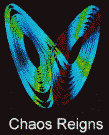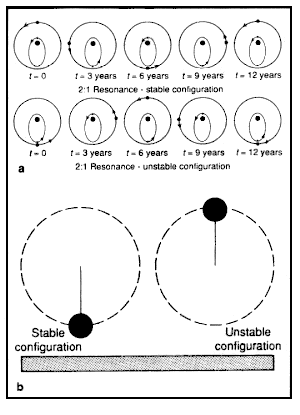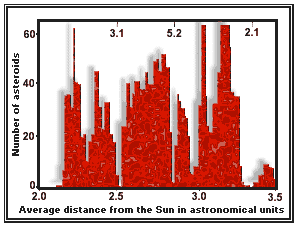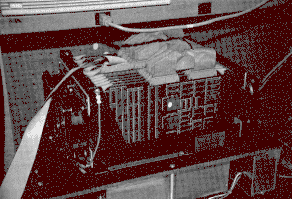

Carl Murray
You might be surprised to learn that the Earth's orbit round the Sun, like those of other planets,is chaotic. What does this mean for the future of the Solar System?
People tend to think of the
Solar System as a paradigm of order
and regularity. We imagine the planets fixed in their orbits around the Sun
for all time - an orderly, predictable, unchanging, majestic clockwork that
never needs rewinding. We can steer the Voyager 2 spacecraft nearly 5 billion
kilometres on a 12-year journey from the Earth to an encounter with Neptune,
so it arrives on schedule within kilometres of its target. We can accept
unforeseen changes in our everyday lives and even come to terms with natural
and man-made disasters, yet we still have faith in the immutability
of the orbits of the planets and satellites.
What grounds do we have for such beliefs? Is the behaviour
of the Solar System completely predictable, or could the planets ever collide?
This is a question that many astronomers have attempted to answer, but it
is only in this decade that a better understanding of the problem and a possible
solution has emerged. The key to this progress is the study of chaos,
even simple, deterministic equations can give complicated unpredictable
solutions. Chaos has revealed that our Solar System is not the paragon of
predictability that we once imagined.
In the 17th century
Isaac Newton showed that if two
bodies attract each other with force that was proportional to the square
of the distance between them, then the resulting motion of body relative
to the other would be a precise mathematical curve called a conic
section (that is, a circle, ellipse, parabola or hyperbola). Although
Newton
was not the first person to suggest that the inverse square law of force
was responsible for the motion of
the
planets, his great triumph was to provide a
mathematical proof of the consequences of such a
law.
He showed that a planet moving under the effects of the Sun'
s gravity would describe an elliptical path, and that the period of this
motion would depend only on the average distance from the Sun. In mathematical
terms, he could show that the "two-body problem" was integrable, in
other words, that it was possible to obtain a complete, practical solution
to the problem using relatively simple mathematical equations. So, if we
are interested only in the two-body problem we can predict any future
configuration of the system with an arbitrary precision for all time.
But the Solar System is not composed of just two bodies. It
is the Sun' s gravitational field dominates the motion of planets and that,
to a good first approximation, each an elliptical orbit around the Sun. The
planets also influence each other's motion, however, all according to
the inverse square law. And we can detect these effects although they
are small. For example, the basic ellipse of the Earth's orbit is not
fixed in space:it gradually rotates or
precesses,
at a current rate of 0.3 degrees per century due to perturbations by
the other planets,most notably Jupiter.
French mathematician
Pierre Simon de Laplace tried to solve
the problem of the Solar System's stability by making some simplifying
assumptions about the nature of the gravitational interactions of the planets.
Laplace showed that his simplified system was integrable and that
there were long-term periodicities (typically,tens of thousands of
years) in the movement of the orbits of the planets: he thought he had
achieved the elusive analytical solution. Unfortunately,the very terms that
Laplace had neglected in his theory were those that could provide possible
sources of chaos. So Laplace' s proof of stability has to be
discounted.
Laplace was one of many scientists who had a fundamental
belief that once you had determined the laws governing the Universe,
it was just a matter of solving the equations, with the appropriate starting
conditions, to discover its past and future behaviour and that "nothing
would be uncertain". The study of chaos has revealed that even completely
deterministic systems, such as those involving gravitational interactions,
can be chaotic and that Laplace's world-view was wrong. For example, the
motion of the ball in a spinning roulette wheel is, in principle, a deterministic
system. Although the ball and wheel are subject to known forces, trying to
predict the final outcome is unlikely to be a rewarding experience.
We now know that, except for special cases, the general motion
of many (n) bodies interacting through gravity,
the "n-body problem",
is not integrable. A simpler task is to attempt to solve the three-body problem.
At the end of the 19th century, the French mathematician
Henri Poincaré tackled this
problem in some depth. It is clear from his writings that he was aware of
the unpredictability of some solutions of the equations of motion. He did
not solve the three-body problem; in fact, he proved that a simple, general
solution did not exist. However, Poincaré was the first to appreciate
the complicated behaviour that could result from the gravitational interaction
of just three bodies. He also realised that in the Solar System, chaos and
order, stability and instability were closely connected with a phenomenon
called "resonance" (see "Asteroids and planets in resonance",below).
Resonance pervades the Solar System. It happens when any two
periods have a simple numerical ratio. The most fundamental period for an
object in the Solar System is its orbital period. This is the time it takes
to complete one orbit and depends only on its distance from the central object.
For example, the Jovian satellite Io has an orbital period of 1.769 days,
nearly half that of the next satellite Europa - with a period 3.551 days.
They are said to be in a 2: 1 orbit-orbit resonance. This particular resonance
has important consequences because the perturbations, resulting from
Europa' s gravity, force the orbit of Io to become more elongated,or eccentric.
As Io moves closer to Jupiter and then further away in the course of
a orbit, it experiences significant tidal stresses resulting in the active
volcanoes that Voyager observed.
 |
A resonance may happen when there is a simple numerical
relationship between two periods leads to repeated configurations. Consider
the case of an asteroid and Jupiter orbiting the Sun. For simplicity, we
will be take Jupiter's orbit to be circular and assume that all objects orbit
in the same plane.An asteroid at the 2:1 Jovian resonance will have
orbital period of six years,which is half Jupiter' s period of 12 years.
To see how the resonance can be stable or unstable,consider two possible
initial configurations with the asteroid and Jupiter aligned with the Sun
on the same side of their orbits (conjunction). The asteroid's orbit will
be considerably affected by Jupiter if conjunctions occur when
the asteroid is at its furthermost point from the Sun (aphelion) is
where the two orbits are closest. In the stable case,conjunctions occur at the asteroid's closest point to the Sun (perihelion). The asteroid reaches the danger point of aphelion after three and nine years,but in each case Jupiter is a different point in its orbit. Every 12 years, the initial configuration repeats itself and so the asteroid always avoids conjunctions at aphelion and is in a stable resonant orbit. In the unstable case, conjunctions always occur at the asteroid's aphelion, leading to a repeated, unstable configuration that cannot continue (see Figure a). There is a simple analogy with the motion of a pendulum (see Figure b). |
It is stable when you start the bob in the vertically down position. Any small shifts of the bob will cause oscillations about the stable point. However, if you start the bob in the vertically up position, it can remain balanced there only for a short time before it becomes unstable. In fact, the equations of motion of an asteroid in resonance with Jupiter are very similar to those of a simple pendulum. To introduce chaos into the pendulum system we need only to oscillate the point of suspension in a regular fashion. The equivalent action in the Sun- Jupiter-asteroid system would be to make the eccentricity of Jupiter' s orbit nonzero. |
|
To make things more complicated, Europa is simultaneously in
a 2: l resonance with the next satellite Ganymede, the trio being involved
in an intricate configuration which Laplace had studied.
In the Saturnian system, resonant pairs of satellites include Mimas
and Tethys, Enceladus and Dione, and Titan and Hyperion. Resonances are curiously
absent from the Uranian satellite system, although there have been recent
explanations that invoke the effects of chaos. Among the planets, Jupiter,
with a period of ll.86 years, and Saturn, with a period of 29.46 years, are
close to a 5:2 resonance, yet the only true orbit-orbit resonance between
planets is a curious 3:2 resonance between Neptune and Pluto. C. J. Cohen
and E. C. Hubbard at the U S Naval Weapons Laboratory discovered this in
l965, not by observation, but by a "numerical integration" of the
system. When the equations of motion of a system cannot be solved
by mathematics, a possible alternative is to solve them using a digital
computer . Although such a numerical integration provides less insight
than a mathematical solution,it is one of the most powerful tools in
modern dynamical astronomy.
The most likely reason that resonance is so common in satellite
systems is due to the effects of tides. As a satellite raises a tide
on a planet,there is an exchange of angular momentum between the
bodies,resulting in a change in the orbit of the satellite and in the spin
of the planet. Consequently, the orbits of the natural satellites today may
bear little resemblance to their original ones;this is certainly
true in the case of the Moon. As a satellite
evolves, its orbital period changes and it may encounter a resonance with
another satellite. In certain circumstances, the satellites become locked
in a resonance and continue to evolve tidally, so maintaining the resonant
configuration.The planets do raise tides on the
Sun but these are not so important because of
the greater relative distances involved. This may explain the lack of orbit-orbit
resonances in the planetary system.
 |
Gaps in the asteroid belt occur at locations corresponding to resonances with Jupiter. |
The most striking example of resonance occurs in
the asteroid belt,a collection of more than 4000 catalogued objects
orbiting between Mars and Jupiter. In l867, the American astronomer Daniel
Kirkwood noticed that the asteroid orbits were not
randomly distributed. There were distinct gaps in the belt at locations
that corresponded to resonances with Jupiter. For example,there were no
asteroids at the 3:l resonance - a distance of 2.5 astronomical
units - or at the 2: l resonance at 3-3 astronomical units (see the diagram
above). This was the opposite situation to that found in the satellite systems
where there was a preference for objects in resonance. Although there were
fewer than 100 asteroids known in Kirkwood's day, his conclusions concerning
the association with Jovian resonances were correct, but astronomers have
only recently explained the gaps satisfactorily.
Astronomers had proposed several theories, ranging from the
suggestion that the gaps were a kind of dynamical "illusion" , to the idea
that increased collisions at the resonances had caused asteroid material
to wear down, producing objects too small to be observed. In 1981, Stan Dermott
and I began studies at Cornell University on how the asteroid orbits were
distributed to try to find out which theory was correct. We concluded that
you could explain the gaps in terms of a simple three-body problem involving
the Sun, Jupiter and an asteroid. But we still lacked a mechanism that could
actually remove an asteroid from a resonance, although we recognised that
we could tackle the problem on a computer, by solving the equations of motion
to study the behaviour of an asteroid over millions of years. The main drawback
of such an approach was the expense - computer time is not cheap.
The breakthrough came in 1981 when Jack Wisdom, then a PhD student
at the California Institute of Technology, developed a new numerical method
for studying the motion of asteroids at resonance. Wisdom [Another pertinent
name! -LB] knew about chaotic dynamics, and in particular how to derive
"mappings" to speed up the numerical work. Given the state of a system at
a certain time, a could give a precise, algebraic method for calculating
the at some fixed time interval later. He still had to carry out the mapping
on a computer, but using the mapping speeded up calculations 1000 times.
As part of his thesis work, derived a mapping to study motion at the 3:1
Jovian resonance. He showed that asteroids, moving under the gravitational
effects of the Sun and Jupiter, at this resonance could undergo
large,unpredictable changes in their orbits. Such orbits were
chaotic.Wisdom went on to show that these orbits crossed the
orbit of Mars and would eventually impact or be scattered by the planets.
This was the mechanism of removal that astronomers had
been seeking. Wisdom showed that there was an extensive chaotic zone
at the 3:1 resonance which matched the observed width of the gap. This discovery
was to solve another problem in Solar System dynamics. Most people think
that meteorites are fragments of asteroids that eventually collide with the
Earth.You can measure the "age" of meteorites by finding out how
long they have been exposed to the cosmic rays in the Solar System.
Members of one particular class of meteorite, the chondrites, have very short
exposure ages of only a few million years.George Wetherill,of the Carnegie
Institution in Washington DC, had shown that these meteorites had to
come from the vicinity of the 3:1 resonance, but he lacked a mechanism.
Wisdom provided the mechanism and carried out numerical integrations to show
chaotic orbits of objects at the 3:1 resonances could become eccentric
enough for them to start crossing the Earth's orbit.
The whole problem of where objects in Earth-crossing orbits
come from is more than an abstract academic question. The impact of a large
asteroid on the Earth would be one of the worst natural disasters that our
planet could face. The 3:1 gap is not entirely clear of asteroids. At
least two asteroids in the gap, Alinda and Quetzalcoatl, are actually in
resonance with Jupiter, and 1989 AC, the asteroid that will pass within just
0.011 astronomical units of the Earth in 2004, is also probably in resonance
with Jupiter at the gap. It is important for dynamicists studying
the Solar System to understand where such objects come from and
how they evolve. This requires a knowledge of chaos.
The two periods involved in a resonance relation do not have
to be orbital periods. Another common form of resonance in the Solar
System is spin-orbit resonance, where the period of spin (the time it takes
the orbit to rotate once about its axis) has a simple numerical relationship
with its orbital period. For example,Mercury is locked in a 3:2 spin-orbit
resonance.A more obvious example is our own Moon, which is in synchronous
rotation because of the 1:1 spin-orbit resonance that forces it to keep the
same face towards the Earth. The far side of the Moon was completely hidden
from us until the era of spaceflight. Most natural satellites in the Solar
System are in synchronous spin states although this was not their original
state : they have evolved into such configurations because of tidal
effects. A simple theory allows us to predict the timescales for evolution
into the synchronous state. The timescale depends on the mass of the satellite
and its distance from the central object.
Prior to the Voyager encounters with Saturn, people had wondered
whether or not the satellite Hyperion was in synchronous rotation. After
all, it is small and one of the most distant of the Saturnian satellites.
Observations from Voyager 2 revealed an irregularly shaped object shaped
rather like a hamburger, or a potato. Measurements of Hyperion's rotation
made by Voyagers 1 and 2 suggest a spin period of 13 days, compared with
an orbital period of 21 days, so Hyperion does not appear to be in an obvious
spin-orbit resonance.
In 1984, Jack Wisdom and Stan Peale working at the University
of California, Santa Barbara, and Francois Mignard of C E R G A, Grasse,
published a classic paper in which they showed that the simple theory worked
out for satellite rotations does not apply to Hyperion, because it is distinctly
nonspherical. Hyperion's rotation is certainly not synchronous, but neither
is it regular; it is chaotic. Furthermore, Wisdom, Peale and Mignard showed
that Hyperion is also "attitude unstable" , which means that its spin axis
is not fixed and the satellite is tumbling in space as well as rotating
chaotically. In normal circumstances, the satellite orbit would become more
circular and eventually the chaotic behaviour would disappear, but, ironically,
tiny Hyperion is locked in an apparently stable 4:3 orbit-orbit resonance
with the massive satellite of Saturn, Titan. This forces Hyperion's orbit
to be eccentric rather than circular, so the chaos persists, resulting in
a satellite with a chaotic spin but a regular orbit.
So chaotic motion does exist in the Solar System in a variety
of forms. But are the orbits of the planets chaotic? The answer to
this question is likely to come from long-term integrations of the planetary
system using a new generation of digital computers. In this decade, there
have been a number of separate efforts to investigate the motions of Jupiter,
Saturn, Uranus, Neptune and Pluto. The inner planets are notoriously difficult
to include in such integrations because very small time-steps are needed
to follow them accurately.
 |
The Digital Orrery numerically integrates orbits in the Solar System. It is attached to a computer workstation at the Massachusetts Institute of Technology and can study the motions of 10 gravitationally interacting bodies at 60 times the speed of a VAX minicomputer. |
An international consortium of Solar System dynamicists led
by Archie Roy of the University of Glasgow, carried out Project LONGSTEP
(Long-term Gravitational Study of the Outer Planets) on the Cray supercomputer
at the University of London. This involved integrating the orbits of the
outer planets for 100 years. Its results revealed several curious exchanges
of energy between the outer planets, but no signs of gross instability .
Another project involved constructing the Digital Orrery by Gerry Sussman
and his group from the Massachusetts Institute of Technology. The group used
this machine, which has a computer architecture designed to mimic the
interactions between the planets, to integrate the orbits of the outer planets
over 845 million years (some 20 per cent of the age of the Solar System).
In 1988, Sussman and Wisdom produced integrations using the Orrery which
revealed that Pluto's orbit shows the tell-tale signs of chaos, due in part
to its peculiar resonance with Neptune. This does not mean, however, that
the resonance is unstable or that Pluto and Neptune could ever collide, even
though their orbits intersect. Recent work suggests that this chaos arises
from resonances within resonances; these can limit the extent of Pluto's
wandering and preserve the main resonance with Neptune.
If Pluto's orbit is chaotic, then technically the whole
Solar System is chaotic, because each planet, even one as small as Pluto,
affects the others to some extent through gravitational interactions. But
we now realise that although chaos means that some orbits are unpredictable,
it does not necessarily mean that planets will collide - chaotic motion can
still be bounded. In 1989, Jacques Laskar of the Bureau
des Longitudes in Paris published the results of his numerical integration
of the Solar System over 200 million years. These were not the full equations
of motion, but rather averaged equations along the lines of those used by
Laplace. Unlike Laplace, however, Laskar's equations had some 150,000 terms.
Laskar's work showed that the Earth's orbit (as well as the orbits of all
the inner planets) is chaotic and that an error as small as 15 metres in
measuring the position of the Earth today would make it impossible to predict
where the Earth would be in its orbit in just over 100 million years' time.
Laskar's results still have to be confirmed by integrating the
full equations of motion, but this will have to wait until the next generation
of supercomputers arrives. Meanwhile, we can take comfort from the fact that
his work does not imply that orbital catastrophe awaits our planet, only
that its future path is unpredictable. It seems likely that the Solar
System is chaotic but nevertheless confined, although we have yet to prove
it.More than 300 years after the publication of Newton's Principia,
we are still struggling to understand the full implications of his square
law of gravity. We have begun to view our system of chaos in a light that
is revealing the true intricacies of its majestic clockwork.
FURTHER READING ANITA M. KILLAIN, Playing dice with the Solar System, Sky and Telescope, Vol. 72, l987, p. 24l. |
| Chaos | Quantum | Logic | Cosmos | Conscious | Belief | Elect. | Art | Chem. | Maths |
The New Scientist
Guide to Chaos File Info: Created Updated 14/9/2017 Page
Address:
http://leebor2.100webspace.net/Zymic/solarsys.html